
A political party is an organization that coordinates candidates to compete in a particular country's elections. It is common for the members of a party to hold similar ideas about politics, and parties may promote specific ideological or policy goals.
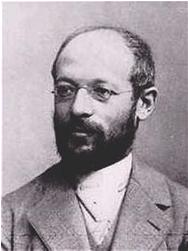
Georg Simmel was a German sociologist, philosopher, and critic.
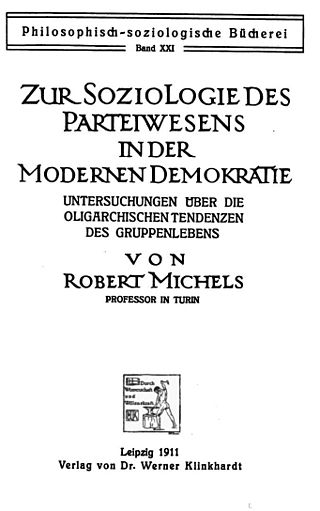
Political Parties: A Sociological Study of the Oligarchical Tendencies of Modern Democracy is a book by the German-born Italian sociologist Robert Michels, published in 1911 and first introducing the concept of iron law of oligarchy. It is considered one of the classics of social sciences, in particular sociology and political science.
A party system is a concept in comparative political science concerning the system of government by political parties in a democratic country. The idea is that political parties have basic similarities: they control the government, have a stable base of mass popular support, and create internal mechanisms for controlling funding, information and nominations.
Reinhard Bendix was a German-American sociologist.
Modernization theory holds that as societies become more economically modernized, wealthier and more educated, their political institutions become increasingly liberal democratic. The "classical" theories of modernization of the 1950s and 1960s, most influentially articulated by Seymour Lipset, drew on sociological analyses of Karl Marx, Emile Durkheim, Max Weber, and Talcott Parsons. Modernization theory was a dominant paradigm in the social sciences in the 1950s and 1960s, and saw a resurgence after 1991, when Francis Fukuyama wrote about the end of the Cold War as confirmation on modernization theory.

Comparative politics is a field in political science characterized either by the use of the comparative method or other empirical methods to explore politics both within and between countries. Substantively, this can include questions relating to political institutions, political behavior, conflict, and the causes and consequences of economic development. When applied to specific fields of study, comparative politics may be referred to by other names, such as comparative government.

Seymour Martin Lipset was an American sociologist and political scientist. His major work was in the fields of political sociology, trade union organization, social stratification, public opinion, and the sociology of intellectual life. He also wrote extensively about the conditions for democracy in comparative perspective. He was president of both the American Political Science Association (1979–1980) and the American Sociological Association (1992–1993). A socialist in his early life, Lipset later moved to the right, and was considered to be one of the first neoconservatives.
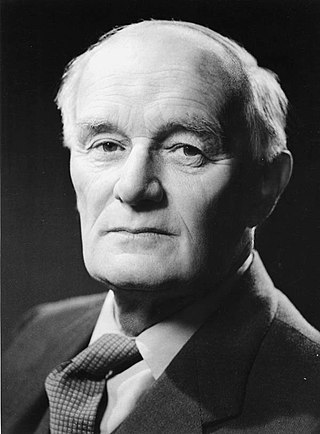
Thomas Humphrey Marshall was an English sociologist who is best known for his essay "Citizenship and Social Class," a key work on citizenship that introduced the idea that full citizenship includes civil, political, and social citizenship.
Stein Rokkan was a Norwegian political scientist and sociologist. He was the first professor of sociology at the University of Bergen and a principal founder of the discipline of comparative politics. He founded the multidisciplinary Department of Sociology at the University of Bergen, which encompassed sociology, economics and political science and which had a key role in the postwar development of the social sciences in Norway.
In political science, political engineering is the designing of political institutions in a society and often involves the use of paper decrees, in the form of laws, referendums, ordinances, or otherwise, to try to achieve some desired effect.
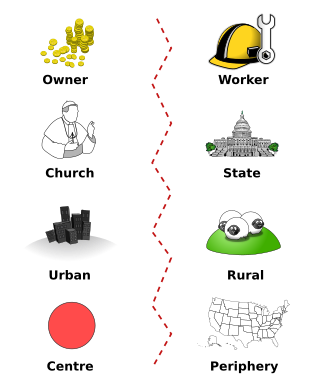
In political science and sociology, a cleavage is a historically determined social or cultural line which divides citizens within a society into groups with differing political interests, resulting in political conflict among these groups. Social or cultural cleavages thus become political cleavages once they get politicized as such. Cleavage theory accordingly argues that political cleavages predominantly determine a country's party system as well as the individual voting behavior of citizens, dividing them into voting blocs. These blocs are distinguished by similar socio-economic characteristics, who vote and view the world in a similar way. It is distinct from other common political theories on voting behavior in the sense that it focuses on aggregate and structural patterns instead of individual voting behaviors.
Peter Flora is an Austrian citizen and taught until his retirement in spring 2009 as a professor of sociology at the University of Mannheim. Peter Flora is a son of the Austrian drawer, caricaturist, graphic artist and illustrator Paul Flora.
Gabriel Øidne was a Norwegian geographer and historian. Analyzing regional differences in party choice in Norway, he was the first to pinpoint factors relating to relations of production as well as counter-cultural cleavages when describing distinctions between Eastern and Western Norway. He also wrote several works on his native region, Agder, among others on the so-called child migration in older times.
In the politics of the United States, the radical right is a political preference that leans towards ultraconservatism, white nationalism, white supremacy, or other far-right ideologies in a hierarchical structure which is paired with conspiratorial rhetoric alongside traditionalist and reactionary aspirations. The term was first used by social scientists in the 1950s regarding small groups such as the John Birch Society in the United States, and since then it has been applied to similar groups worldwide. The term "radical" was applied to the groups because they sought to make fundamental changes within institutions and remove persons and institutions that threatened their values or economic interests from political life.
"The Stranger" is an essay by Georg Simmel, originally written as an excursus to a chapter dealing with the sociology of space in his book Soziologie. In this essay, Simmel introduced the notion of "the stranger" as a unique sociological category. He differentiates the stranger both from the "outsider" who has no specific relation to a group and from the "wanderer" who comes today and leaves tomorrow. The stranger, he says, comes today and stays tomorrow. The stranger is a member of the group in which he lives and participates and yet remains distant from other – "native" – members of the group. In comparison to other forms of social distance and difference the distance of the stranger has to do with his "origins". The stranger is perceived as extraneous to the group and even though he is in constant relation to other group members; his "distance" is more emphasized than his "nearness". As one subsequent interpreter of the concept put it, the stranger is perceived as being in the group but not of the group.
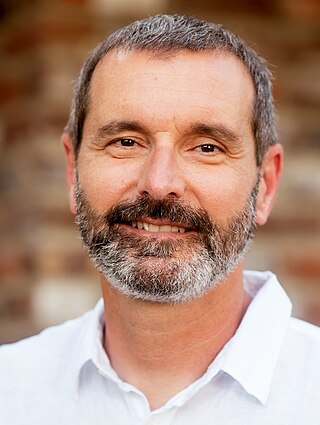
Romain Wacziarg is an economist who has served as a professor of economics at the UCLA Anderson School of Management since 2011, where he has also held the Hans Hufschmid Chair in Management since 2015. He was previously a professor of economics at the Stanford Graduate School of Business. His research interests span international economics, political economy, economic growth, and economic development.
Critical juncture theory focuses on critical junctures, i.e., large, rapid, discontinuous changes, and the long-term causal effect or historical legacy of these changes. Critical junctures are turning points that alter the course of evolution of some entity. Critical juncture theory seeks to explain both (1) the historical origin and maintenance of social order, and (2) the occurrence of social change through sudden, big leaps.
Andreas Wimmer is a Swiss sociologist who is the Lieber Professor of Sociology and Political Philosophy at Columbia University. He has a PhD in social anthropology from the University of Zurich.

Daniele Caramani is a comparative political scientist.







